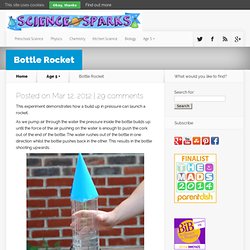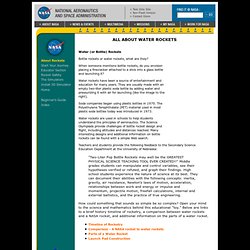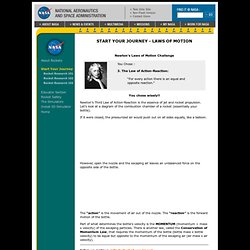

Bottle rocket. This experiment demonstrates how a build up in pressure can launch a rocket.

As we pump air through the water the pressure inside the bottle builds up until the force of the air pushing on the water is enough to push the cork out of the end of the bottle. The water rushes out of the bottle in one direction whilst the bottle pushes back in the other. This results in the bottle shooting upwards. What you need an empty plastic bottlecardboard made into a cone and 4 finsa corka pump with a needle adaptorwater Instructions Push the needle adaptor of the pump through the cork, it needs to go all the way through so you might have to trim the cork a little bit.Decorate the bottle with the cone and fins.Fill the bottle one quarter full of water and push the cork in tightly.Take the bottle outside and connect the pump to the needle adaptor. Warning! Please make sure an adult is around as the rocket takes off very suddenly and forcefully as you can see in this video clip.
Science for hobbyist, students, and teachers of all ages. Q: How much water do you put in a water rocket?

A: The simple answer is something less than half full. Since the compressed air stores the energy, and the water provides momentum, both are needed. Fill perhaps 40-50% of the motor volume with water. We call this the Load Fraction. The longer answer is, it depends. The following factors effect how much water is optimal: Empty weight of the rocket, cross-sectional area (or diameter) of the rocket, nozzle diameter, operating pressure, and drag coefficient. So how do I determine the optimal load fraction? By conducting experiments, we are rocket scientists after all! Is there another way? Yes, conduct your experiments using a water-rocket simulator like our java-based applet.
(back) Bang Goes the Theory - Hands-on science: Water bottle rockets. Water Rocketry - About Bottle Rockets. Bottle rockets or water rockets, what are they?

When someone mentions bottle rockets, do you envision placing a firecracker attached to a stick into a glass bottle and launching it? Water rockets have been a source of entertainment and education for many years. They are usually made with an empty two-liter plastic soda bottle by adding water and pressurizing it with air for launching (like the image to the right). Soda companies began using plastic bottles in 1970. The Polyethylene Terephthalate (PET) material used in most plastic soda bottles today was introduced in 1973. Water rockets are used in schools to help students understand the principles of aeronautics.
Teachers and students provide the following feedback to the Secondary Science Education Department at the University of Nebraska: "Two-Liter Pop Bottle Rockets may well be the GREATEST PHYSICAL SCIENCE TEACHING TOOL EVER CREATED!! " How could something that sounds so simple be so complex? Water rocket. A water rocket is a type of model rocket using water as its reaction mass.

Such a rocket is typically made from a used plastic soft drink bottle. The water is forced out by a pressurized gas, typically compressed air. Like all rocket engines, it operates on the principle of Newton's third law of motion. Operation[edit] Simplified animation of how a water rocket works. 1) compressed air is added which creates a bubble that floats up through the water and then pressurizes the air volume in the top of the bottle. 2) The bottle is released from the pump. 3) The water is pushed out the nozzle by the compressed air. 4) The bottle moves away from the water because it follows Newton's Third Law. The bottle is partly filled with water and sealed. Water and gas are used in combination, with the gas providing a means to store potential energy, as it is compressible, and the water increasing the mass fraction and providing greater force when ejected from the rocket's nozzle.
Elements[edit] Water Rocketry. You chose wisely!!

Newton’s Third Law of Action-Reaction is the essence of jet and rocket propulsion. Let’s look at a diagram of the combustion chamber of a rocket (essentially your bottle). If it were closed, the pressurized air would push out on all sides equally, like a balloon.